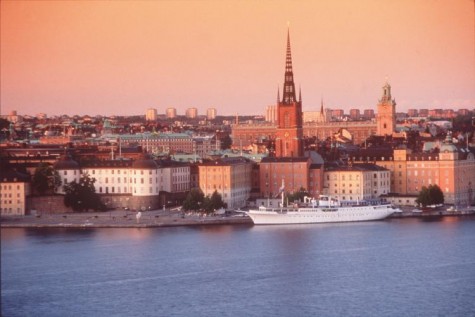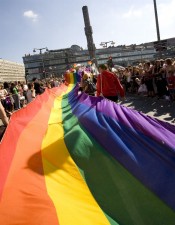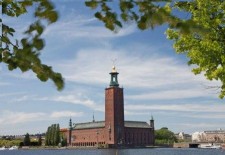Stockholm: A Great LGBTQ Destination

Stockholm’s Pride Week shows why the city is one of the world’s most enjoyable GLBT destinations.
by Brendan Lemon
The first sign that my trip to Stockholm would be wonderful (the first sign, that if, after a silky smooth ride on SAS from Newark to the Swedish capital) was the taxicab that picked me up at the city’s well-organized airport. The cab sported a decal that said “Stockholm Pride.†I thought this sign was unique to that automobile until I was whisked into the city center and noticed that every other taxi also seemed to have this notice. Not only that: the city’s buses were flying rainbow flags. Had I died and gone to gay heaven?
In many ways, yes. Stockholm’s gay pride week, which culminated with a parade on July 31, is a reflection not only of the highly resourceful Stockholm Gay & Lesbian Network but of the city, indeed the country, itself. There are Pride events within Stockholm’s gay meeting places; but the celebration is remarkably well-integrated into the larger society. Christina Guggenberger, who co-founded the Network, told me one night at the Pride Park – the fair-like center of gay-week activities, including big-name live performers and all kinds of commercial and political displays – that in the contemporary era Sweden has generally wanted to integrate LGBT folks into the wider world and not shunt them off into Chelsea- or Castro-like ghettos.

A Sophisticated GLBT Program
For purposes of smart tourism, Stockholm has wisely developed a sophisticated gay program, which has helped make the city one of the world’s top GLBT destinations. This program, Guggenberger said, grew out of the realization that gay tourists from less progressive parts of the world may feel more comfortable with a more targeted rainbow welcome.
My own welcome was rich, various, and highly colourful – an apt reflection of Stockholm itself. The generalized image of the city may be a Blondes-Only zone, but in fact Sweden, like any country in the globalized era, has been reflecting more diversity. At each nightclub I visited – from the charmingly converted old theatre Berns to the basement den Paradise – I noticed all shapes and sizes of gay people. Some of them may have been from out-of-town; so many Swedes speak fluent English, however, that it’s often difficult to determine nationality from a conversation overheard amidst the thump-thump of a disco.
The Pride parade itself, held on Saturday afternoon, was the perfect combination of political floats and organizations. No Pride group in any part of the globe will ever be closer to my heart than New York’s Lesbians For Patsy Cline, but I now have a runner-up, from Stockholm: Lactose-Intolerant Gays.
If the Stockholm Parade was dotted with such humorous delegations, it also included more serious, political segments. Watching the celebration, I had the expert commentary of Henrik Friskopp, who is the Director of Operations for the Hilton Stockholm Slussen Hotel, where I was housed spectacularly with a room having a view of Stockholm’s Old Town and some of its myriad bridges and waterways. (The hotel is pictured below.)

As the parade float of each political party passed, Henrik would tell me just where that party stood on the issues and about its recent evolution. Even Sweden’s conservative party (conservative in Sweden being equivalent to moderate in the U.S.) has become more gay friendly: not a bad strategy this year, when there’s a national election (in September) that polls suggest will be close.
Stockholm Historical Sites
Today’s politics, of course, have past roots, and one of the many, many joys of my visit to Stockholm during its Pride week was my tour of some of the city’s historical sites. One morning, a polyglottal guide named Elisabeth took my Pride-visitors group (which included a Brit, a Spaniard, two Germans, and two Italians: each one was memorable) for a quick breeze-through of a few of Stockholm’s best-known places.
We joined the hordes at the Vasa Museum, which houses an enormous wooden ship that set sail from Stockholm harbor in 1628 and promptly sank.

We had a less boisterous, equally pleasurable visit to the Stockholm City Hall, a beautiful brick building (pictured left) completed in 1923 that is the venue of the Nobel Prize banquet each December. Couples may also marry at city hall (same-sex marriage has been legal in Sweden since 2009), and the guide, Elisabeth, said there is a long version of the ceremony (just over 4 minutes) and a short version, which, at under a minute, doesn’t even allow time for a proper kiss.
The city hall also has a Gallery of the Prince, used for official receptions, whose paintings were done by Prince Eugene (1865-1947), a noted patron of the arts and a lifelong bachelor. (You do the math.)
One of the city hall’s mosaics is of Queen Christina, who became queen of Sweden in 1632 but abdicated in 1654 and joined the Church of Rome. Christina is the Swedish monarch best-known to foreigners because of the movie, “Queen Christina,†in which she was played by home-town girl Greta Garbo (whose Stockholm burial place, Woodland cemetery, is worth a visit). Like Garbo herself, Christina had a sometimes queer vibe.
That Christina is a favorite of Stockholm’s LGBT community was apparent the day after my VASA/City Hall tour, when my little band (or, at least those in the group who weren’t still recovering from late-night revels) visited a well-preserved private house in the posh Stureplan area that was built over a hundred years ago by the ornamental sculptor Axel Notini and is now maintained by the Stockholm City Museum. (That museum, near the Hilton hotel on Sodermalm island, Stockholm’s gayest neighborhood, is well worth a visit, and among other things runs a Milennium tour, based on the books by Sweden’s current top, post-ABBA cultural export: Stieg Larsson.)
At the name Stureplan house, my group was given a highly entertaining, highly informative chat by an amateur historian named Nadia, who has put together a Transgender tour of Stockholm for the city museum. Nadia pointed out that, despite being Sweden’s best-known monarch, Queen Christina has no statue dedicated to her anywhere in Stockholm. (All monarchs who have received such an honor are male: even progressive Sweden needs a nudge once in a while.) I have visions of mounting a Facebook campaign to redress the city’s cruel neglect of Christina. But to do that, I suppose, might be seen as my being an ungrateful visitor to a vibrant city, Stockholm, whereas the truth is that it is a colorful, well-organized, fun metropolis that I love more and more each time I visit.
I guarantee that you would love it too – at Pride week or at any other time of the year.
IF YOU GO:

Transport: SAS is by far the best way to fly to Sweden from the United States, with direct flights from Newark, Chicago, and Washington, D.C. Once you arrive in Stockholm, the best way to go from the airport to the center city is the fast train, the Arlanda Express.
Lodging: The Hilton is a wonderful, centrally located hotel. Click here for other gay-friendly places to stay.
Restaurants: There are many gay-owned and gay-friendly restaurants and cafes in Stockholm. Two of the most charming are Malarpaviljongen and Patricia.
General Information: By far the best source of information about Stockholm for the LGBT traveler is located on the website of the Stockholm Gay & Lesbian Network. There you will find information about hotels, restaurants, nightclubs, and places of historical interest. You will also find special offers targeted to the LGBT traveler and to Stockholm visitors in general.
PHOTO CREDITS: Preben Kristensen – Stockholm Visitors Board; Yanan Li – Stockholm Visitors Board
